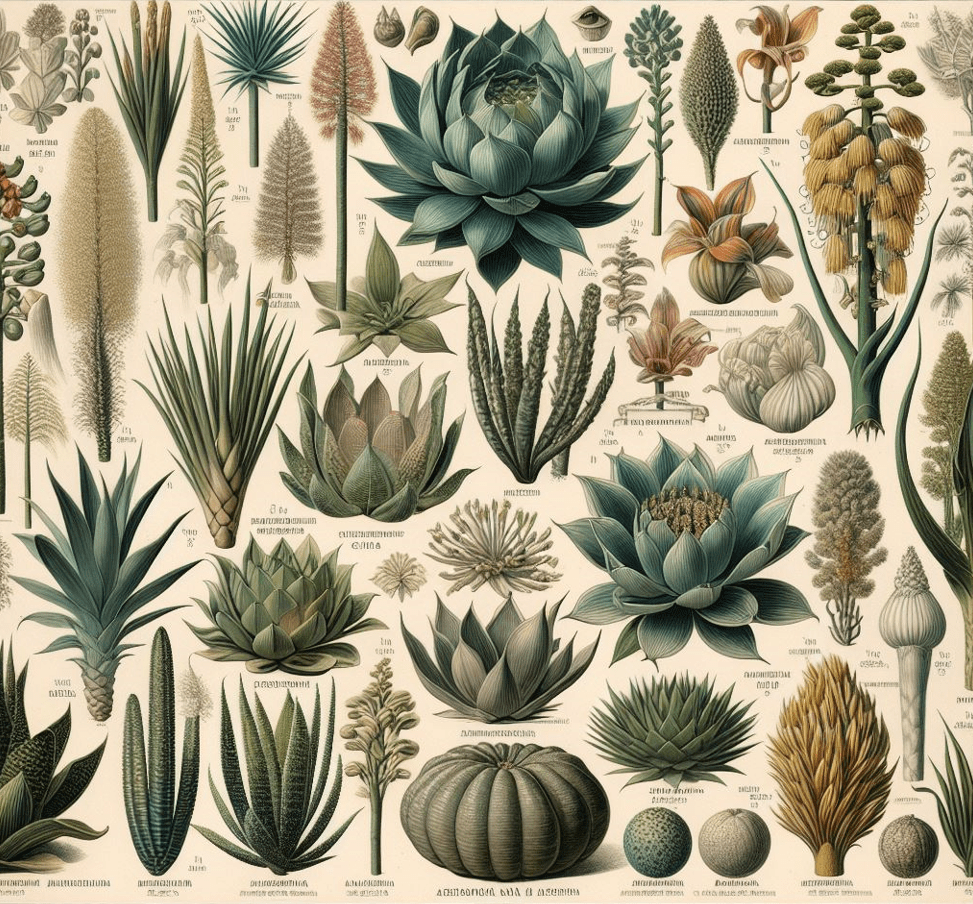
If you enjoy eating asparagus, growing yuccas, or admiring agaves, you are already familiar with some members of the Asparagaceae family. This large and diverse group of flowering plants includes over 300 genera and 3,000 species. They are found in almost every habitat and region except for Antarctica.
The Asparagaceae family is part of the order Asparagales, which also contains other well-known families such as Orchidaceae (orchids), Amaryllidaceae (amaryllis), and Iridaceae (irises). The Asparagaceae family itself is divided into seven subfamilies, each with its distinctive characteristics and genera.
Here are some examples of each subfamily:
- Agavoideae: This subfamily contains many succulent plants adapted to dry environments. They have thick leaves that store water and often form rosettes. Some produce tall flower stalks that can reach several meters in height. Examples of genera in this subfamily are Agave, Yucca, Furcraea, and Hesperaloe.
- Aphyllanthoideae: This subfamily consists of only one genus, Aphyllanthes, which has two species of herbaceous plants native to the Mediterranean region. They have blue flowers and grass-like leaves that lack a midrib.
- Asparagoideae: This subfamily includes the genus Asparagus, which contains about 300 species of herbaceous plants with edible shoots or roots. Some are cultivated as vegetables, such as Asparagus officinalis (garden asparagus). In contrast, others are grown as ornamental plants, such as Asparagus plumosus (plumosus fern) and Asparagus densiflorus (asparagus fern).
- Brodiaeoideae: This subfamily contains about 12 genera and 70 species of bulbous plants that produce showy flowers in various colors. They are native to North and South America and are popular as cut flowers or garden plants. Examples of genera in this subfamily are Brodiaea, Dichelostemma, Triteleia, and Milla.
- Lomandroideae: This subfamily contains about 15 genera and 170 evergreen plants with stiff or flexible leaves and small flowers. They are native to Australia, New Zealand, Southeast Asia, and the Pacific Islands. Some of them are grown as ornamental plants or for their fiber. Examples of genera in this subfamily are Lomandra, Cordyline, Xanthorrhoea, and Dianella.
- Nolinoideae: This subfamily contains about 25 genera and 400 species of mostly evergreen plants with broad or narrow leaves and small flowers. They are native to tropical and subtropical regions of Africa, Asia, Europe, and the Americas. Some of them are grown as houseplants or for their medicinal properties. Examples of genera in this subfamily are Dracaena, Sansevieria, Beaucarnea, and Aspidistra.
- Scilloideae: This subfamily contains about 80 genera and 1,800 species of primarily bulbous plants that produce colorful flowers in clusters or spikes. They are native to temperate and tropical regions of Africa, Asia, Europe, and the Americas. Many of them are grown as spring-flowering bulbs or garden plants. Examples of genera in this subfamily are Hyacinthus (hyacinths), Scilla (squills), Muscari (grape hyacinths), and Ornithogalum (star-of-Bethlehem).
- Asparagaceae asparagus family: The most economically important member of the asparagaceae is the asparagus, which is cultivated for its edible shoots. Other members of the family have medicinal, ornamental, or cultural uses.
Identify plants and flowers of Asparagaceae
The Asparagaceae family is a large and diverse group of plants that includes common garden plants and houseplants. Here, You can See Photos that will help You identify the most prominent members of the Aspargacea family.
-
- Asparagus (Asparagus officinalis): A popular garden vegetable grown for its edible shoots. Asparagus plants have a fern-like appearance, with delicate green fronds that emerge from thick, woody stems.
-
- Yucca (Yucca spp.): A group of succulent plants native to North America. Yuccas have long, sword-like leaves and produce clusters of white or yellow flowers. Some popular yucca species include Yucca elephantipes (Mexican soaptree yucca), Yucca gloriosa (Spanish bayonet), and Yucca filamentosa (Adam’s needle).
-
- Bluebells (Hyacinthoides non-scripta): A group of spring-blooming bulbs native to Europe. Bluebells have bell-shaped flowers that are typically blue, pink, or white. They are a popular choice for naturalizing in woodlands and meadows.
-
- Hosta (Hosta spp.): A group of shade-tolerant perennials famous for their large, glossy leaves and attractive flowers. Hostas come in various colors: green, white, yellow, and purple. They are easy to care for and make a great addition to shady gardens.
-
- Snake plant (Sansevieria trifasciata): A popular houseplant that is known for its tolerance of neglect. Snake plants have tough, upright leaves that are striped green and yellow. They are easy to care for and can thrive in low-light conditions.
-
- Corn cane (Dracaena fragrans): A popular houseplant known for its tall, upright stems and attractive foliage. Corn canes have sword-like leaves that are green, yellow, or variegated. They are easy to care for and can add a touch of elegance to any home.
-
- Spider plant (Chlorophytum comosum): A popular houseplant that is known for its ability to reproduce rapidly. Spider plants have long, slender leaves that arch over and produce small plantlets (spiderettes) at the tips. These plantlets can be easily propagated to create new plants.
-
- Plumosus fern (Asparagus setaceus): A popular houseplant known for its delicate foliage. Plumosus ferns have long, feathery fronds that can grow up to 3 feet long. They are easy to care for and can thrive in humid conditions.
These are just a few of the many plants and flowers that belong to the Asparagaceae family. With its diverse species, this family offers something for everyone, whether you’re looking for a hardy outdoor plant, a low-maintenance houseplant, or an edible vegetable.
Final Word
As you can see, the Asparagaceae family is a diverse and fascinating group of plants that offers something for everyone. Whether you are looking for food, beauty, or utility, you can find it among the asparagus relatives.






















